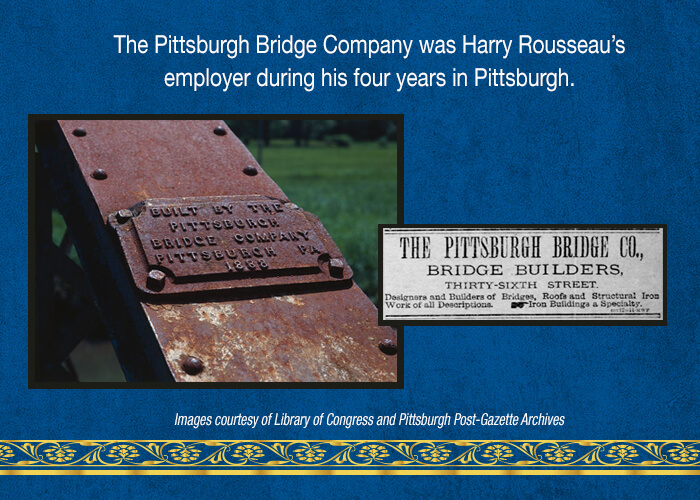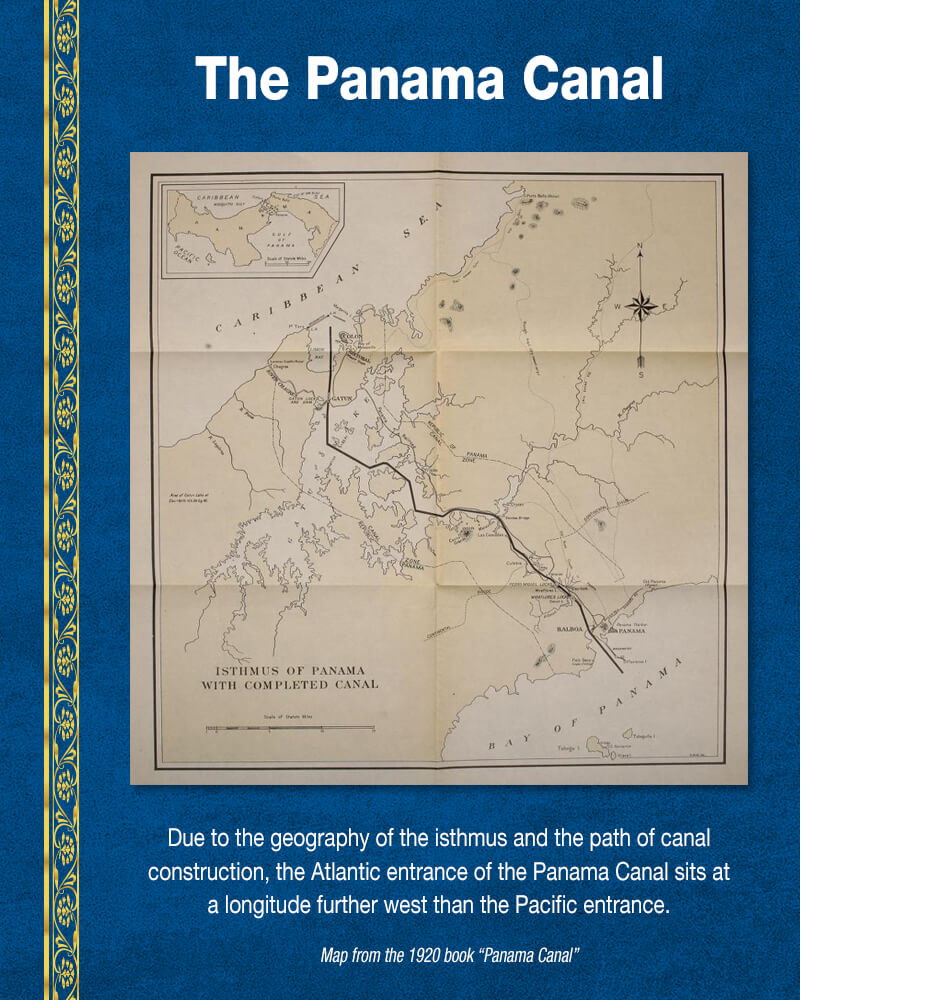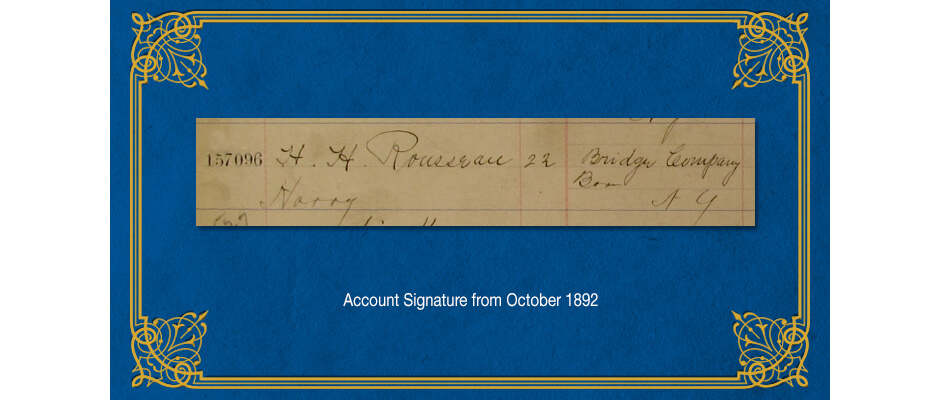Harry H. Rousseau

1870-1930
Harry Harwood Rousseau was born in Troy, New York to Jeanette and William Rousseau, who dealt in insurance and real estate. Harry Rousseau excelled in academics and was the valedictorian of his senior class at Troy High School in 1887. He earned a bachelor’s degree in civil engineering from Rensselaer Polytechnic Institute in 1891.
After working as a structural engineer in New York state, Rousseau came to Pittsburgh in 1894, where he was employed by the Pittsburgh Bridge Company. Founded in 1860, the Lawrenceville-based firm constructed bridges, viaducts and buildings throughout Pennsylvania. Rousseau was promoted to principal assistant engineer and remained with the Pittsburgh Bridge Company until 1898.

Rousseau joined the Navy’s Civil Engineering Corps in late 1898 as a lieutenant junior grade. His orders assigned him to the Bureau of Yards and Docks, where he worked directly under Chief Rear Admiral Mordecai Endicott. Over the next several years, Rousseau was involved in the planning of naval stations at Pearl Harbor, Hawaii, Charleston, South Carolina, and the Great Lakes.
In 1903, Rousseau was assigned to Mare Island Navy Yard in California, established in the 1850s under the command of CDR David Farragut as the first U.S. Navy base on the Pacific Ocean. At Mare Island, Rousseau supervised construction of a dry dock and the dredging of a channel at Pinole Point to allow access for that era’s heavier, more modern battleships. Rousseau designed a flusher to keep the channel free from sediment.
Rousseau’s orders returned him to Washington, D.C. in late 1906, where he was appointed chief of the Bureau of Docks. In this capacity he served only a few months before he was chosen by President Theodore Roosevelt to serve on the third Isthmian Canal Commission. The ICC had been established in 1904 to oversee construction of the Panama Canal, after the U.S. had purchased excavation equipment and a railroad from the French, who had been attempting to build a canal since 1881.
Critical to the massive engineering project was suitable infrastructure for the tens of thousands of canal workers and their families – housing, water and sewer systems, mess halls, hospitals, schools, warehouses, machine repairs shops and a railroad able to handle the heavy freight to build all these things.
Harry Rousseau’s job was to address these needs. He arrived in Panama in early 1907 and took charge of the Department of Building Construction, Motive Power and Machinery, and Municipal Engineering, managing some 10,000 employees.
In 1908, the chairman of the ICC, Lt. Col. George W. Goethals, appointed Rousseau as Assistant to the Chief Engineer, leading the Second Division of the Chief Engineer’s Office. Rousseau served in this capacity, working directly for Goethals, until April 1914, when the ICC as an administrative body was terminated. Four months later, in August 1914, the canal officially opened, and ships began to use the Panama Canal to transit between the Atlantic and Pacific Oceans.
In 1911, Rousseau was instructed to supervise the construction of the canal terminals at Cristobal (the Atlantic entrance) and Balboa (the Pacific entrance). He oversaw the design and building of dry docks, breakwaters, piers, wharves and floating cranes – whatever was necessary to accommodate the Navy and merchant traffic that would be using the canal.
The terminals were not yet completed when the ICC was terminated in April 1914, so Rousseau stayed on as engineer in charge of the terminals project. Rousseau was advanced to the rank of Rear Admiral in March 1915. He continued to work on canal zone construction until May 1916.
During his decade spent in Panama, Rousseau married and started a family. His wife was Gladys Squiers, daughter of the U.S. Minister to Panama. The couple had three sons.
After his work on the Panama Canal was completed, Rousseau and his family returned to Washington, D.C., where Rousseau resumed assignments for the Navy. As a member of the Helm Commission, he helped study and report on the nation’s coastal defenses, specifically with respect to naval bases and air stations. He also served as Director of Naval Petroleum Reserves, and sat on the promotion board of the Civil Engineering Corps.
Rousseau passed away at sea, after suffering a stroke while aboard the SS Cristobal en route to the Canal Zone. His body was returned to the United States, and he was interred at Arlington National Cemetery.
In 1932, Rousseau was honored with his likeness being put on a 20-cent stamp used in the Canal Zone. It was appropriate, since his work on the Panama Canal was his greatest career achievement, but Rousseau had also distinguished himself by becoming the youngest rear admiral in the history of the U.S. Navy and the youngest head of the Civil Engineering Corps.
In 2017, Rousseau was inducted into the Alumni Hall of Fame at his alma mater, Rensselaer. His graduation from the institute in 1891 was not the last time he was at the school. He delivered the commencement address there in 1923.
Harry H. Rousseau opened a savings account at Dollar Bank in October 1892 during a business trip to Pittsburgh. He listed his employment as “bridge company,” and he stayed in a rented room on Main Street in Lawrenceville during his sojourn in the city. Less than two years later, he would return to Pittsburgh as an employee of the Pittsburgh Bridge Company.
